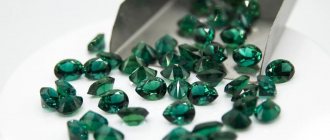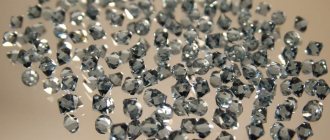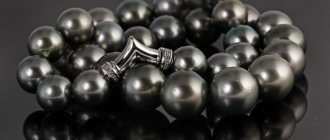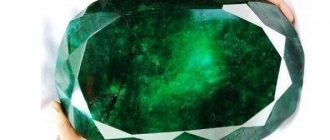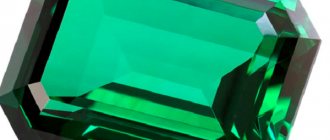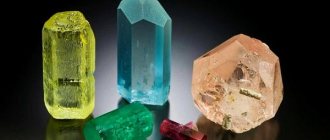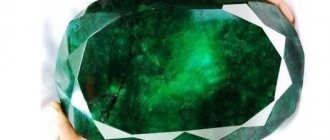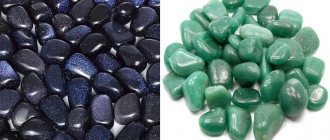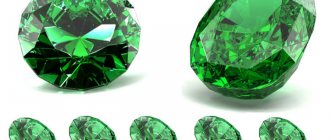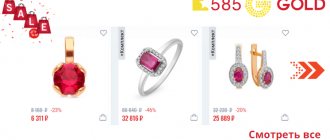| Category | Beryls |
| Title in English | Emerald |
| Formula | Be3Al2Si6O18 |
| Group | Beryl group |
| Color | Yellowish-green, Green |
| Stroke color | White |
| Shine | Glass |
| Transparency | Transparent, Translucent |
| singonia | Hexagonal |
| Hardness | 7,5 — 8 |
| Cleavage | Imperfect |
| Density, g/cm³ | 2,69 — 2,78 |
| Kink | Conchoidal, Uneven |
| origin of name | Emerald jewelry was sold back in Babylon, and this is the 3rd millennium BC. Although, historians say that evidence has been found that emerald mining was carried out back in the 19th century BC. The field was located near the Red Sea and was controlled by the Egyptians. Due to the fact that humanity has long been familiar with this precious stone, the history of the emergence of the term “emerald” is rooted in the deep past. The modern form of the Russian word emerald owes its appearance to the Turkish word zümrüt. It, in turn, comes from the Persian zumurrud. But the Persians have already borrowed their version from Greek. The Greeks used the term σμάραγδος or smaragdos - green stone. It is interesting that even the ancient Greeks did not completely own the word. They used a root from the Semitic language - brq. It is translated as “to shine.” The English version of the name for emerald, emerald, also appeared thanks to the Greek. But this word came to Europe from vulgar Latin (common) - Esmaraldus. In ancient French the term was written as Esmeraude. In Middle English it became Emeraude, modified over time and got the form we have now. By the way, the name Esmeralda is translated as a green gem or emerald. |
| Morphology | The natural formation of emeralds occurs due to the interaction of felsic magma with rocks that host ultramafic igneous rocks. Therefore, the natural place of formation of emeralds is represented by zones with high or medium-temperature leaching - greisenization. Rarely, there are cases of emerald formation due to exocontacts of pegmatites. But it is worth considering that then the stones come in small sizes. It is believed that the best quality emeralds come from hydrothermal veins located in carbonaceous shales. |
Emerald is a gemstone from the beryl group of the first order and is equal in value to diamond, sapphire, ruby, chrysoberyl, alexandrite, noble spinel and euclase. The quality of a mineral is determined by its color characteristics and degree of transparency. An ideal specimen should be absolutely transparent with a uniform, rich color. A large, flawless, brightly colored emerald weighing over 5 carats is valued even more expensive than a diamond.
Emerald deposits
High-quality emeralds are rare and are mined in countries such as Colombia, New Granada, Zambia, Brazil and Egypt.
Low quality samples are common in Austria, Ireland, and Norway. — Advertising —
In addition, Russia, USA, Canada, Australia, Spain, France, Switzerland, Italy, Germany, Bulgaria, Kazakhstan, Pakistan, Afghanistan, India, China, Cambodia, Ethiopia, South Africa, Somalia, Nigeria, Namibia, Tanzania are well known among emerald suppliers. , Zimbabwe, Mozambique and Madagascar.
MORPHOLOGY
Emerald occurs in various species in nature. Brazilian emerald has a transparent green tint. Quite a rare name Trapiche, emeralds of this type have the shape of a carriage wheel with spokes. They are usually found in Colombia. Another type is called emerald - malachite or eurohit. The next variety of emerald is called Vilyuisk or Vesuvian. There are also copper emerald or dioptase, Ural or demantoid and nickel emeralds.
History of emerald
The term “emerald” has Persian roots, which were transformed into the Latin smaragdus and were then used by many peoples of the world.
Even in ancient times, emeralds were highly valued. In Babylon they were an object of trade as early as 4000 BC. e. Ancient Egypt was famous for its emerald mines, which were discovered in the 19th century along with tools from 1300 BC. e. The rulers of India also valued emeralds. Sultan Shah Jahan, who built the magnificent Taj Mahal, the greatest symbol of love and fidelity, used emeralds as talismans. In addition, they were engraved with sacred texts.
And now, like many centuries ago, emeralds remain one of the most popular gems.
Record emerald
— Advertising —
The world's largest emerald, originally from Colombia, was named "Fura". Its weight was 11,000 carats and its price was $150 million. The second largest mineral, named “Tena,” weighs 2,000 carats. The record holder for cut stones called “Theodora” weighing 11.5 kg was valued at $1,500,000. Before treatment, his weight was 28 kg.
Physico-chemical characteristics of emerald
Emerald is a type of beryl, a colorless stone that is colored by impurities of certain metals.
Thus, emeralds are characterized by a rich velvety green color, with a blue tint due to the presence of chromium, iron and vanadium in the mineral composition. Emerald crystals have an elongated prismatic shape. They are transparent or translucent, fragile with a glassy sheen, without cleavage, uneven or conchoidal at the edges.
The hardness of emerald on the Mohs scale is 7.5-8.0. The specific gravity is 2.8 g/cm3. Refraction from 1.576 to 1.582.
STRUCTURE
Emerald belongs to the hexagonal system of the dihexanal-bipyramidal symmetry class. Impurities of chromium 1-2%, sodium, potassium, lithium, cesium, rubidium, iron, vanadium are noted. The main motif of the framework structure of beryl is represented by the six-wheel structures of the SiO4 ring - tetrahedra - Si6O18, connected to each other by BeO4 - tetrahedra in hexagonal columns with large channels inside such columns. These columns are connected to each other by BeO4 - tetrahedra and AlO6 - octahedra.
Magical properties of emerald
The main task of the emerald is to overcome the bad inclinations of its owner: deceit, a tendency to cheat, and infidelity to loved ones.
If the owner of the stone does not have such inclinations, then the emerald will bring him good health and success. And if the gem doesn’t like a person’s behavior, he can even punish him. Emerald reacts especially poorly to aggression and rudeness. Emeralds dispel negative energy, cleanse a person’s aura and his home from everything negative. They are considered the patrons of the family hearth: they maintain peace and harmony between spouses, and have a positive influence on procreation.
Psychics use emeralds to contact the souls of the dead and understand signals from higher powers.
Who suits the name
Smaragd is the patron stone:
- Elena , whom she will make wiser and more patient.
- Julia . The gem will protect her from troubles and disappointments and make her luckier in all respects.
- Isabella , whose aura will be cleared of accumulated negativity. Another stone will help the owner of the name to return her husband’s love and save her family, realize her creative potential and become a self-sufficient person.
- Peter , who will help get rid of bad habits, and also teach him to think soberly and protect him from mistakes.
- Klim . The emerald will help him forget past failures in love and tell him where to look for his soul mate.
- Herman . The stone will show this man the shortest and least thorny path to financial well-being, teach him not to despair, be philosophical about “falls,” learn from his own mistakes and draw the right conclusions.
The healing properties of emerald
Emeralds can stabilize blood pressure, relieve pain in the head and joints, and help in the treatment of diseases of the gastrointestinal tract and bladder inflammation.
They are characterized by a pronounced antibacterial effect. Previously, the stone was used to treat night blindness, cataract, and epilepsy. Modern lithotherapy suggests using the gem to eliminate nightmares, insomnia, groundless fears and increased fatigue.
Industries where emerald is used
The main use of emeralds is their use in jewelry.
Rich dark green samples are considered the most valuable; even if they contain foreign inclusions, they are valued more than pale stones. Emerald inserts decorate jewelry and are kept in museums and private collections. In addition, natural emeralds are used in the manufacture of solid-state lasers, and synthetic stones are used in quantum electronics.
Methods for refining crystals
It is better for overly impressionable jewelry connoisseurs not to know how gems are mined industrially. If previously soft soil was carefully loosened with sticks, now the rock containing emerald ore simply explodes. In this case, not only those minerals that could be located at the place where the charge was placed suffer. Since such a characteristic of emerald as strength leaves much to be desired, due to the shock wave, a rare stone in the destroyed rock does without cracks, or even splitting.
In order to make them less noticeable and prevent further destruction of the gem, cracks were previously treated with oil, mainly cedar, which has a refractive index similar to the mineral. African craftsmen still prefer oil processing, but rarely do any of them manage to completely hide defects. But in South American countries, cracks are now filled with epoxy resins. For this purpose, special vacuum or thermal devices are used. Other crack fillers include adhesive silicone, natural latex, and even silicate glue. More than 95% of stones on sale were refined in one way or another.
The preservation of the fragile mineral is also facilitated by a special type of cut, which protects it from accidental damage and best reveals its rich color. It has a square or rectangular shape with chamfered corners. For a sample that has a large number of cracks, only grinding without edges, in the shape of a pearl or cabochon, is used, since with other types of processing it can crumble.
Gold ring DIAMONDS OF KOSTROMA with emerald and diamonds (go to the SUNLIGHT catalog)
For particularly fragile gems, a special mount with a closed bottom is used. However, this means that the crystal will transmit less light and will dim even when slightly dirty. Cleaning must be done with the utmost care. The stone should not be rinsed in a soapy solution, as it will wash out the oil that fills the cracks. The use of any solvents should be completely avoided. Ultrasonic cleaning devices cause particular damage to the mineral. Every time you remove jewelry, you need to thoroughly wipe the stone with a flannel rag. Then it will look like new for a long time, and it will not soon require professional cleaning in a jewelry workshop.
Artificial emerald
Since the 19th century, scientists from many countries have been involved in the task of creating artificial emeralds.
For the first time this was possible only in 1935 in Germany, when G. Espig and his colleagues obtained the so-called “igmerald”. 5 years later, industrial production of the synthetic mineral was established in the USA. Today, artificial emeralds are produced in countries such as Germany, France, Switzerland, Japan, Russia and Belarus. The world's largest (a joint enterprise between Russia and Thailand) synthesizes emeralds that are identical in chemical composition to natural Colombian ones. Synthetic emeralds often reach large sizes up to hundreds of carats, but the technology for their production remains a secret of the enterprises and is not disclosed.
In general, modern synthetic emeralds are no different in appearance from natural ones, and the quality is even higher. Moreover, their price is much lower than natural stones, which are quite rare.
ORIGIN
Emeralds are formed by the interaction of acidic magma with host ultramafic igneous rocks, so their deposits are represented by greisenization zones. Occasionally, small emeralds are formed in the exocontacts of pegmatites.
In most deposits of the world, emerald is associated with phlogopite mica, formed as a result of greisenization - the impact of high-temperature aqueous solutions on ultrabasic rocks. As a result of this process, the original rocks, due to the feldspars of granites, are transformed into complex rocks containing quartz, light mica and often valuable ore minerals in the form of inclusions. The presence of greisen is a leading search indicator for deposits of rare metal ores and precious stones, including emerald.
The best quality emeralds are confined to hydrothermal veins located in carbonaceous shales. Colombian emeralds occur in low-temperature carbonate veinlets cutting through black bituminous limestones.
How to distinguish an artificial emerald from a natural one
Artificial emerald is very similar to natural stone, but its specific gravity and refractive index are lower. In addition, it is characterized by a bluish-green tint. In the Chelsea filter it looks bright red. It is also possible to distinguish between natural and synthetic emeralds using ultraviolet radiation (wavelength 360 nm), a real stone does not react to it, but a synthetic one luminesces in a chestnut-brown color. But this pattern may not be observed.
Differences between natural gems
There are several ways to distinguish natural stone from artificial:
- Compare prices. The cost of natural stones is significantly higher than that of artificial analogues.
- Study the information on the tag attached to the product and quality certificates.
- When visually examined, natural stones can show foreign inclusions and internal microdamages. The edges of both stones are parallel, but in artificial specimens they are at an equal distance. Real stones do not reflect the sun's rays. Artificial stones change color when exposed to ultraviolet rays.
- Tactile sensations. Before purchasing, you must hold the stone or jewelry in your hand. The artificial stone will change the temperature. A natural gem will retain its original physical properties. The mass of natural stones is greater than that of hydrothermal samples.
A pronounced surface shine is a sign not just of the artificial origin of the stone, but of an obvious fake made of glass. And also the absence of any internal defects should alert a potential buyer, as it may mean that this copy is a crude fake.
Emerald products are suitable for both young and mature people. They look elegant and discreet, but always help the owner stand out from the crowd. But it is worth remembering that only natural stones have healing and magical properties.
Emerald and zodiac sign
Emeralds are recommended for nervous people with increased sensitivity; it helps them avoid stress and exposes scammers and deceivers.
The gem is well suited for Leo, Libra and Aquarius. Emerald is absolutely not recommended for Pisces, Capricorns and Scorpios. Representatives of other zodiac signs can wear jewelry with it without any worries.
Medicine or amulet?
The magical properties of emerald have been known for a long time. It was believed that he was able to extinguish any quarrel, as he compensates for negative energy. When worn constantly, it gradually pacifies the temper of people who are quick-tempered and have an unstable psyche. The main meaning of the stone is the fight against evil human tendencies. It symbolizes wisdom and insight, and if the person to whom it was given is unfaithful, it fades and acquires a brownish tint.
Emerald and its synthetic analogue can equally be used in a magical ritual to establish peace in the house. To do this, the crystal is moved from room to room, leaving it in the most visible place for 12 hours. Thanks to its magical properties, the stone frees its owner from bad influences, and his home from negative energy. It can be used as an amulet against the evil eye and, unlike most gems, can be passed on by inheritance while preserving all the positive qualities. The advantage of artificial crystals is that initially they do not carry any information, and the owner with strong positive energy is able to endow the stone with magical powers.
Who is the most suitable precious variety of beryl? These are people born under the signs of Leo, Libra and Aquarius. But Scorpios, Capricorns and Pisces are better off avoiding the stone. It won’t hurt others to wear it, but most of all it is indicated for owners with well-developed intuition. The healing properties of the mineral are manifested in a calming effect and relief from nightmares, which significantly alleviates the condition of people suffering from cardiovascular diseases.
Prices for emerald products
Low-quality emerald prices start at $350 per carat, while high-quality stones start at $8,500 per carat, which is influenced by the color, clarity and origin of the stone. As the weight of a gem increases, its value also increases. Thus, specimens with rich color and weight of 5 carats are valued at $15,000 per carat.
Emerald color
What color is emerald? This question interests many people. The main color of the stones is green. The shade is affected by the presence of impurities. These include: chromium oxide, iron oxide, vanadium oxide.
If we talk about color, emerald has 5 main varieties. They depend on the tone and lightness. As a rule, stones are divided by shade:
- light;
- medium light;
- medium - it is often called herbaceous;
- medium dark;
- dark.
When purchasing a natural stone, you need to take into account that emerald contains many inclusions and cracks. Therefore, its purity should not be assessed too strictly.
Emerald can have a darker or lighter shade.
